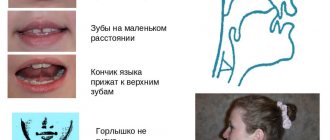A child begins to pronounce whistling sounds correctly at about 3-4 years of age. But some children have problems with articulation. If measures are not taken promptly, speech dysfunction will persist for life. To create whistling sounds, a set of special exercises is usually prescribed. They are performed both in classes with a speech therapist and at home.
The importance of making a whistling sound
Speech defects that develop in childhood can lead to communication difficulties in adulthood. Therefore, the production of whistling sounds must be carried out in a timely manner. The earlier a deviation is detected, the greater the chances of its successful elimination. Typically, defects become noticeable when the child enters the middle group of kindergarten. Speech therapists distinguish two types of disorders:
- parasigmatism;
- sigmatism.
With sigmatism, the child’s pronunciation of the sound “s” in soft and hard forms is distorted. With parasigmatism, its replacement occurs. Deviations in spoken language can have a negative impact on the functioning of the nervous system. This subsequently leads to low self-esteem and communication disorders. Against the background of incorrect pronunciation, the following develops:
- Dyslalia is a disease characterized by difficulty pronouncing certain sounds.
- Dysgraphia is a deviation accompanied by the replacement and rearrangement of letters during writing.
- Dyslexia is a reading problem caused by the inability to combine letters into a single text.
What is a speech disorder
All articulation deficiencies are systematized depending on the violation of the pronunciation of a certain group of speech sounds. There are seven in total:
- rhotacism - distortion of sounds [р] and [р'];
- lambdacism - [l] and [l'];
- sigmatism - [zh], [w], [h], [sch], as well as [s]-[s'] and [z]-[z'];
- iotacism - [th];
- kappacism - distortion of the posterior palatal sounds [k]-[k'], [g]-[g'], [x]-[x'];
- gammacism - [g] and [g'];
- hitism - [x] and [x'].
As can be seen from the above list, sigmatism is the most extensive group. This is due to the proximity of the patterns of the listed sounds during pronunciation. Thus, the patterns of sounds [s]-[z] and [sh]-[zh] are the same (they differ only in the presence of voice in a voiced consonant).
Preparatory activities
Before performing exercises aimed at developing conversational speech, breathing training is carried out.
She teaches how to blow a stream of air from the lungs. To make the training more interesting for the child, it is recommended to use a small cotton wool or ball. The most common exercises that develop breathing include the following tasks:
- It is necessary to prepare an empty small bottle. Its neck should be brought to the lower lip. A stream of air is directed into the bubble. If the baby does everything correctly, a characteristic sound appears. This exercise is called “storm”.
- The palms need to be placed on the stomach. Then a deep breath is taken through the nose, after which the breath is held for a couple of seconds. Exit is through the mouth. The purpose of the exercise is to teach the child to control the air stream. The task is called "accordion".
- The “breeze” exercise is performed by stretching out the lips with a tube. A deep breath is taken through the nose. Then a palm is placed to the lips, and a stream of air is released through the mouth.
How to set sound mechanically
Speech development can also be carried out mechanically. In this situation, it is recommended to actively use special simple exercises:
- “Depict” a wide smile on your face, with your tongue in an interdental position. An important condition is not to touch the upper row of teeth. After some time, the mouth muscles relax, then the exercise is repeated again.
- The next step is to blow on the tip of the tongue, which should be protruding from the oral cavity. To feel the air stream, you should place your palm to your lips.
- While the child is blowing air, you need to press on the tongue with a toothpick. This will help form a groove through which the air stream is directed.
- At the next stage, the jaws close, but the toothpick remains between them. It helps fix the tongue in the desired position. The passage of an air stream will cause a whistle.
- While playing the whistling sound, you need to press a toothpick on different parts of the tongue, identifying in which position the “s” will sound correctly.
- After the child manages to pronounce the desired sound, the exercise is performed without using a toothpick.
Speech material
Modern speech therapy has extensive speech material for every age and taste. In addition to collections of tongue twisters, tongue twisters, and proverbs, there are various “speech notebooks” designed to help a child master their native speech. Selecting material for a specific child will not be difficult.
Parents should take note that if a speech therapist advises studying according to a certain manual, you should not, in defiance of the specialist, buy notebooks in “convenient” stores. The determination of mom and dad for the child to achieve certain results is half the success, and joint work with a speech therapist, as a rule, is a success.
Staging from other sounds
The correct pronunciation of “s” can be formed from other sounds. In this case we will talk about the sounds “ts” and “sh”. Initially, the child should reproduce “sh” in a drawn-out manner. Then the tongue gradually moves towards the teeth, without leaving the palate. "Sh" will gradually transform into a fuzzy whistling sound. To get a “s” out of it, you need to clench your teeth. After this, the child must repeat the attempt to replace one sound with another.
The production of whistling consonant sounds from “ts” is less common. The essence of the method is the drawn-out pronunciation of the sound “ts”. The child will not have to change the position of the tongue. The sound is automatically transformed into “s”. After this, it is recommended to consolidate the result with the help of tongue twisters or poems.
Speech therapy diagnostics
The speech therapist looks at the state of the articulatory apparatus: the state of the bite, the muscle tone of the tongue and lips. To do this, he asks the preschooler to perform exercises to maintain a certain position and dynamic tasks. In addition, the speech therapist evaluates speech breathing: watches how the baby inhales and exhales, asks to play the pipe.
To diagnose sound pronunciation, a specialist selects speech material in which C is at the beginning, middle and end of the word. In this case, there should be no mixed sounds in the words. This is the Z, C and hissing group. First, the speech therapist asks you to say the sound in isolation, then in syllables, words, phrasal speech and sentences. Then he asks the child to write a story or describe what is drawn in the picture and pays attention to how S sounds in ordinary speech.
Then they make a diagnosis of phonemic processes. The speech therapist names the sounds, and the child must do a certain action when he hears the right one. Gradually, the specialist complicates the speech material, naming syllables and words. Then the patient is asked to name the desired word from a pair of paronyms and select words with the desired sound from the list.
Based on diagnostic data, the speech therapist draws up a plan of correctional work. If the speech disorder is complex, then the child needs to be provided with comprehensive assistance. It includes the joint work of a speech therapist, neurologist, and defectologist.
What methods exist for sigmatism
The production of the sounds “s”, “z” and “ts” with sigmatism is carried out in several ways. They are selected based on the nature of the deviation. Sigmatism is a distortion of the pronunciation of the sound “s”. The nature of the origin of the pathology is determined in the speech therapist's office. Possible causes of sigmatism include:
- neuritis;
- perceptual deviations;
- improper development of the maxillofacial apparatus;
- recently lost baby teeth;
- disturbances in figurative thinking.
Most often, sound pronunciation is corrected with the help of exercises, but in some cases a mechanical method may be required. The set of articulation exercises will vary in each individual case.
Interdental sigmatism
The deviation is characterized by the incorrect placement of the tongue between the teeth. It rests against the edges of the upper or lower incisors, which creates an obstacle to the passage of the air stream. “C” in this case changes to “t”. The main reason for this violation is considered to be the incorrect structure of the conversation between parents and the child. The likelihood of interdental sound is reduced with the necessary interaction between the baby and adults.
To correctly pronounce whistling sounds, they resort to imitation. In this case, the child tries to repeat after the adult. If this method does not produce results, installation is carried out mechanically.
Lateral sigmatism
Speech impairment with lateral sigmatism is accompanied by insufficient activity of the muscle tissue on the sides of the tongue. When trying to pronounce sounds, the tip of the organ rests on the area of the alveoli. Speech becomes completely unclear. A set of special exercises helps to improve sound pronunciation. Among the most effective are:
- alternate inflation and retraction of the cheeks;
- maximum opening and closing of the jaw, provided that the tongue is located at the bottom of the mouth;
- prolonged imitation of chewing with the mouth closed;
- rotation of the tongue in the predental area with the oral cavity slightly open;
- suction of an air stream through a tube made from the tongue.
Nasal sigmatism
Nasal sigmatism develops as a result of incomplete closure of the posterior wall of the pharynx with the soft upper palate. This happens when there is damage to the nervous system or when there are clefts in the palate. An exercise that involves blowing out the sound “f” helps to cope with this form of deviation. The child should place the wide part of the tongue between the lower lip and the upper incisors. From this position the sound “f” is pronounced. In the meantime, the tongue should be gradually retracted behind the teeth.
Dental parasigmatism
One of the causes of parasigmatism is malocclusion of the teeth. In this case, speech therapy exercises are used to produce speech. The emphasis is on the baby's tactile sensations and the correct location of the articulation organs. Initially, a soft “s” is set. Breathing work is being done. For these purposes, the child puts his hand to his mouth and directs the air flow onto it, after taking a deep breath. If he manages to pronounce “s”, there is no need to complete the lessons. It is necessary to consolidate the result by periodically repeating the exercises.
Why can't my child pronounce the letter "S"?
There are many reasons for not pronouncing the letter “s”:
- broken bite;
- psychological instability - family quarrels, fear, etc.;
- neurological causes;
- poor hearing;
- presence of bilingual parents;
- incorrect anatomical structure of articulatory organs;
- genetic predisposition;
- baby talk;
- lack of communication with adults and peers.
The true cause can only be determined by a qualified specialist after carrying out comprehensive diagnostic measures.
If you have precisely mastered the technique of how to teach your child to pronounce “s” correctly, do not expect that he will learn to do it in 2-3 lessons. Sometimes, during speech therapy games, a child is able to pronounce a whistling sound, but he cannot use it in words and phrases. Don't worry, this is normal. Just be patient and caring.
A set of articulation exercises
Differentiation of whistling patients is based on the performance of exercises that the speech therapist selects individually. Among the most effective are the following:
- It is necessary to open your mouth wide in a smile without closing your teeth. After a few seconds, you can relax your lip muscles. The exercise is repeated 5-6 times.
- The starting position is the same as in the previous exercise. You need to run the tip of your tongue along the gums, simulating brushing. First, attention is paid to the upper teeth, then to the lower teeth.
- The mouth stretches into a smile, after which the tip of the tongue should touch the corners of the lips one by one. The chin should be motionless at this moment.
- The tongue protrudes as much as possible. First, it must be pulled to the tip of the nose, and then to the chin. After this, you should alternately touch the wide side of your tongue to your lips.
- With your teeth completely closed, you should stretch your lips into a tube as much as possible. The exercise is repeated 5 times.
How to consolidate the results of classes
To achieve the desired result, you should work with a speech therapist on an ongoing basis. It is strongly recommended not to quit classes at the first improvement in pronunciation. Sound fixation is carried out through automation. This process involves the use of individual sounds when pronouncing syllables, phrases and sentences. During classes with a speech therapist, you are given tasks that help improve your speaking skills. The automation stage is considered the most difficult. Activities help develop speaking skills and introduce learned sounds into everyday speech. The main task of parents is to facilitate the process by prompting and helping the child.
The most effective way to consolidate results is to read aloud. At the initial stages, you can pronounce simple tongue twisters. In the future, you need to move on to more voluminous texts. It is important to maintain a conversation with your baby. This not only trains speech, but also develops hearing.
For dysarthria in children, physiotherapy, drug treatment and speech therapy massage are used in combination with exercises. Dysarthria develops in 3-6% of cases. It is accompanied by increased tone and excessive tension in the muscles of the articulatory organs. A specific feature of the disease is the difficulty of overcoming defects. Therefore, the process of speech restoration takes much more time.
Corrective work
If a child is diagnosed with a speech disorder, if all the results of the appropriate examination are available, correction can and should begin. At the same time, all possible pathogenic factors identified during an appointment with specialists are eliminated. Correction of interdental sigmatism is carried out in three stages:
- Preparatory. It involves the formation of positive motivation, the development of sound analysis skills, and the preparation of the muscles of the tongue, jaws and lips for producing sounds.
- Formation of correct articulatory structure. This is the production, automation and differentiation of sound in syllables and words of different syllabic composition.
- Introduction of sounds into independent speech. Assumes correct pronunciation of sound in all communication situations.
This is what correction of sound pronunciation looks like in case of dyslalia - impaired sound pronunciation against the background of intact hearing and innervation of the speech apparatus. With the right approach, the correction of interdental whistling sigmatism is corrected within three to five months with the correction of 2-3 sounds. But it can last from one to two years if correction of 6-10 sounds is required.
If interdental sigmatism is a concomitant disease, then this work is planned in conjunction with the correction of the underlying disease. For example, correcting sound pronunciation for dysarthria will consist of the following steps:
- Preparatory. It takes place against the background of treatment prescribed by doctors, physiotherapy, massage and includes the preparation of the speech apparatus, the development of hearing, the ability to control the voice and breathing, and the formation of a vocabulary.
- Formation of pronunciation skills. The stage includes the correction of disorders of the speech apparatus, sound pronunciation, vocal apparatus and breathing, the formation of skills in sound analysis and synthesis, and communication.
In this case, the formation of communication skills occurs in parallel to the first two stages.
Note to parents
The sounds “ts”, “s”, “sh” can be made at home. In this case, responsibility for the outcome of the training falls on the shoulders of the parents. The following principles must be kept in mind:
- The load on the speech apparatus increases gradually. Otherwise, the baby will not be able to learn new information.
- During the exercises, it is recommended to make associations with the world of animals and insects. The sounds “s” and “z” are compared to the squeaking of a mosquito.
- It is necessary to allow the child to independently find a comfortable position for the organs of articulation to reproduce insulating sounds.
- If your child does the exercises without enthusiasm, it is better to stop exercising. This indicates that he is tired.
- Classes must be regular. The optimal frequency is 2-3 times a week. The duration depends on the nature of the baby’s speech deviation.
- When performing mechanical production of sound pronunciation, objects that are not dangerous to the child should be used. It is desirable that this be a special speech therapy probe.
Possible associated developmental disorders
Interdental sigmatism can be a symptom of such developmental disorders as open bite and other abnormal forms of development of the speech apparatus, enlarged adenoids, hypotonia of the speech muscles (this is how dysarthria manifests itself). In all of these cases, the cause of the speech defect should be eliminated together with correctional work by a speech therapist. If you ignore diseases, you may not see the results of speech therapy work.
If an orthodontist helps correct problems in the development of the dental system (with the help of plates and special simulators), then a psychiatrist deals with the treatment of dysarthria, which often frightens parents. In practice, the identified dysarthria at the age of three does not manifest itself in any way by the age of seven, provided proper treatment and timely correctional assistance are provided to the child.
Interdental sigmatism is often a concomitant developmental disorder in diseases such as cerebral palsy, intellectual disability, deafness, and blindness. In these cases, everything depends on the degree of complexity of the underlying disease (the more complex the form, the less opportunities for correction) and the preservation of intelligence. Speech correction for such children lasts for many years and reaches a satisfactory level as much as possible.








